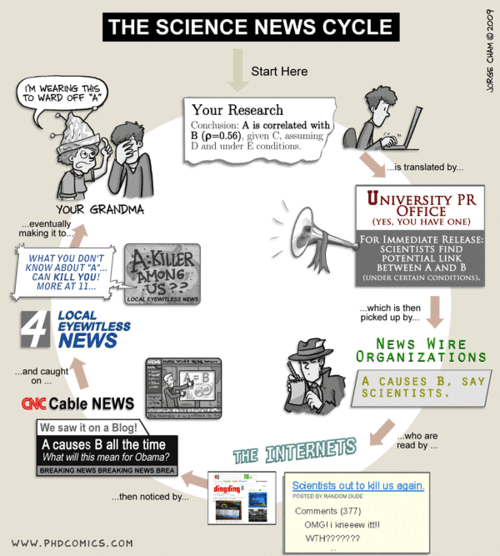This week struck me as a particularly exhausting one when it came to that certain brand of provocatively-headlined-but-probably-not-what-you-think-it-is science news that we know and
lovehate.As usual, it’s the science media click-machine that’s to blame, which is a polite way of saying that there exists a gaping void of careful, cautious, skeptical, dare I say scientific science writing out there amidst the great internet knowledge machine. It’s desperately hard to get people to read your articles or watch your videos, but that doesn’t mean that it’s okay to disengage the gravity of reason and drift off into the aether of just-so stories.
PHD Comics has summed up this vicious form of the science news cycle very well:
It’s not all bad, of course. There’s some real diamonds that we can regularly depend on to shine through amid the soiled throngs of pseudointellectual beggars out there, and I, along with others, try to highlight their work regularly. I shall do so again here.
Here, I present two cases of “science things that were badly reported” and some links to better explanations. As usual, the defendants come from that tenuous intersection of neuroscience and behavior, because studying the brain is hard stuff, folks.
1) Mice Can Inherit Memories: No they can’t. Well, maybe they can (although I doubt it), but that’s not at all what this widely-reported paper in Nature Neuroscience says. The poor authors of that study are probably at home, drinking, wondering how, after years of hard work, their paper about how mice may pass on sensitivity to smells got so twisted. Headlines ranged from declaring this the source of human phobias to saying that Assassin’s Creed is based in real science.
What the researchers did was to condition some male mice to associate a smell (cherry blossoms) with a mild electric shock, which is mean, because that’s a nice smell! Naturally, the mice began to avoid the odor. The weird part is that their offspring, even two generations down the line, also seemed to avoid that specific cherry blossom odor, without ever encountering it before (and without their dads showing them). The dads’ noses all had more of the cells that smell that odor, as did the noses of their offspring. This did not happen with female mice and their offspring.
These kind of things aren’t supposed to be possible in a single generation. A mouse dad shouldn’t smell something, become afraid of it, and then be able to pass on a change to his kids. That’s precisely the kind of thing that got Lamarck and his giraffe necks laughed at more than a century ago. But it is possible that these mice were transmitting some sort of epigenetic change.
It’s possible that there was an epigenetic change passed down. But it’s not for sure. Beyond that, the way that statistics are applied to mouse behavior studies make it possible that the differences they see are just due to sample sizes, or not including certain controls, or some other random factor like that the humidity on a particular day happened to make the mice very jumpy. There’s also the fact that there is no known way for nerve cell changes or chemical responses within the olfactory bulb to be communicated to the testes, where sperm are made (there’s literally a blood-testis barrier to prevent that kind of thing).
Read this instead: At National Geographic, Virginia Hughes goes through the research in great detail, including comments from several people in the field who remain, shall we say, less than convinced. Extraordinary claims call for extraordinary evidence, and that’s lacking, at least in part. “More work needed” as they say!
2) Men and women’s brains are wired differently, therefore men are better at reading maps. That’s almost a verbatim headline from this news outlet. It speaks of “hardwired differences” (our brains are not hardwired) and is loaded with brainsplaining and neurosexism. This story is frustrating notsomuch because of the science, which is so-so, but because it is being misapplied by the media to reinforce cutsie-pie stories about what men are good at and what women are good at and never the twain shall meet and boy is it funny how men and women argue over getting lost?! GUFFAW!
Read this instead: At Discover, Neuroskeptic explains why the spatial resolution of the techniques used are like making a road atlas, while on the moon, using a pair of binoculars, and how the only real difference here may be that men’s brains are just slightly bigger than women’s (which doesn’t account for any noticeable difference in abilities, but can mess with scans a lot). And if you’d like a nice introduction to the idea of neurosexism and pigeonholing gender-based brain research into outdated social molds, might I suggest you read this article at The Conversation?
The fact is that men and women are mostly the same when it comes to their brains, but “Everyone can probably become pretty good at reading maps whether or not they are male or female, suggests common sense, not needing to be backed up by neuroscience” doesn’t make a very catchy headline.
None of this is to say that any of the results presented in the scientific papers are patently or provably false. But as we communicate the vagaries of Science In Progress, we must include the Don’t Knows and the Possiblys and all the other fine (and frustrating) forms of cautious optimism. It doesn’t kill the excitement. It just comes with the territory. I read it on a map somewhere.

Just another WordPress site


